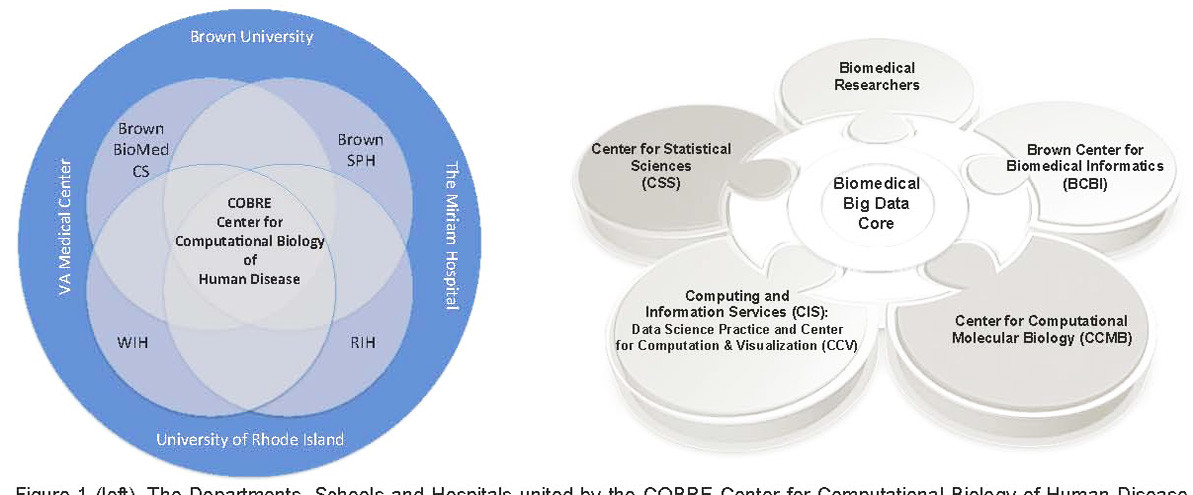Art, science of computational biology research get $11.5 M boost from NIH
New COBRE in Computational Biology of Human Disease was launched by Brown University on June 1, supporting the research of junior faculty to use sophisticated computer analyses to better understand, combat disease
PROVIDENCE – An $11.5 million award by the National Institutes for Health has enabled Brown University to launch a new Center of Biomedical Research Excellence, or COBRE, beginning on June 1, focused on the Computational Biology of Human Disease.
The effort marries together the research expertise at Brown in computing and mathematics with expertise in biology and medicine, funding the efforts of five teams that pair scientists and younger faculty members to pursue studies related to human disease.
Translated, the new Center will serve as a research hub for young faculty in the field that is known as computational biology, supporting their work for the next five years.
The goal is to turn data into information that can be used to better understand the advanced genomics underlying diseases in humans, including cancer, severe lung infections, and preeclampsia, a pregnancy complication characterized by high blood pressure.
The research outcomes sought are to advance new discoveries, algorithms and genomic screening approaches.
David Rand, the chair of the Department of Ecology and Evolutionary Biology, will serve as director of the new center.
The new Center furthers the collaborative framework for research around advanced genomics, helping to build the research infrastructure to support that work.
Researchers at work
The first five projects that got underway on June 1, partnering younger faculty with senior faculty mentors, involve a number of ambitious research studies. They include:
• Amanda Jamieson, assistant professor of molecular microbiology and immunology, will study bioinformatics data to identify the genomic and cellular mechanisms underlying tolerance of viral and bacterial coinfection in the lung. Her mentors will be Dr. Jack A. Elias, dean of medicine and biologic sciences, and Zhijin Wu from the department of Biostatistics in the School of Public Health.
• Nicola Neretti, assistant professor of biology, will use bioinformatics screening of a fruit fly model to identify new drug targets for extending healthy lifespan. He’ll work with mentors Rand and Charles Lawrence, professor of applied mathematics.
• Sohini Ramachandran, assistant professor of Ecology and Evolutionary Biology, will develop new computational and analytical methodologies to identify risk genes for leukemia that differ in incidence across ethnic groups and genders. Her mentors will be Lawrence and Valerie Knopik, associate professor of psychiatry and human behavior at Brown and the Rhode Island Hospital.
• Alper Uzun, assistant professor of Pediatrics, will test the hypothesis that variants in a refined set of gene candidates underlie the complex basis of preeclampsia. He’ll work with Dr. Jim Padbury, William and Mary Oh/William and Elsa Zopfi Professor of Pediatrics at Brown and Women & Infants Hospital, and William Fairbrother, associate professor of biology.
• Shipra Vaishnava, assistant professor of molecular microbiology and immunology, will study the spatial variation in the gut microbiome in response to antimicrobials and immunity pathways that can inform aspects of human irritable bowel disease (IBD). Her mentors will be Professor Richard Bennett from her department and Professor Mitch Sogin from the Marine Biological Laboratories.
“It’s a very ambitious program,” Rand told ConvergenceRI in a recent interview. “It is a support program to foster [building] the research skills of junior faculty in computational biology and human disease.”
Training junior faculty
The Center, Rand explained, has two core functions: to support five junior faculty members to do research; and to build a core of staff people to support the work in computational biology.
“We need to get the biology right,” he explained. “With a stupid experiment, you get stupid results.”
The training goes both ways, Rand continued. “We need to model the questions accurately [in the analyses of] genomic and proteomic data equations, in order to do an experiment that is meaningful.”
It’s a two-way street, Rand said. “Training in biology for the computational folks, and computational folks having access to biological expertise.”
Learning to speak the same language, with the fusion of computational and biological expertise, will be a challenge, Rand said. It is a relatively new experience for the researchers to be working with each other. “Their languages, their ways of thinking, are distinct,” he said.
Breaking down silos
The new COBRE with its collaborative research framework also has an added value of breaking down some of the silos that may existed between Brown and the hospitals in the past, according to Rand.
“The logical thing is to cooperate,” he said, “to collaborate across fields.”
The primary focus of the first, five-year phase of the new COBRE, Rand reiterated, is to define the research teams and support their work. The second phase is building an infrastructure across the university in computational biology.
In the meantime, the nitty-gritty of managing the resources of the new Center, as Rand talked about meeting the deadline for a supplemental budget request to underwrite administrative support to integrate resources among all the existing COBREs at Brown.







